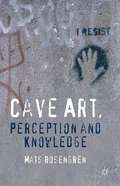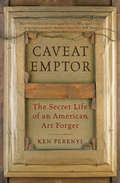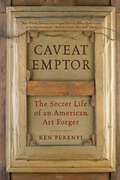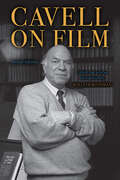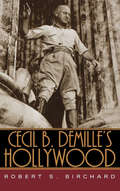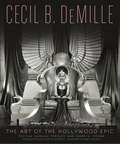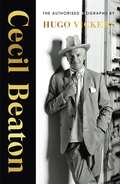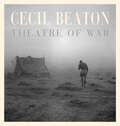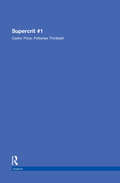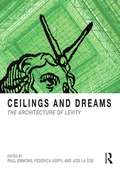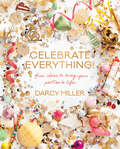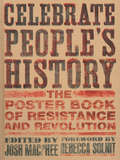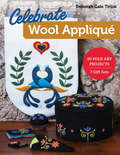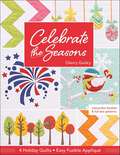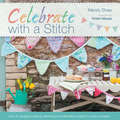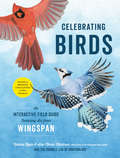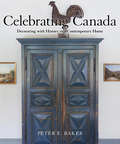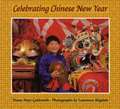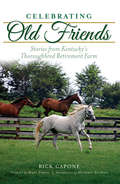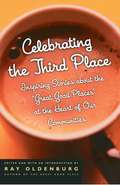- Table View
- List View
Cave Art, Perception and Knowledge
by Mats RosengrenUsing the example of prehistoric paintings discovered in the late 19th century in Spain and France Cave Art, Perception and Knowledge inquires into epistemic questions related to images, depicting and perception that this rich material has given rise to. The book traces the outline of the doxa of cave art studies.
Caveat Emptor: The Secret Life of an American Art Forger
by Ken PerenyiIt is said that the greatest con man in the world is the one who has never been caught--and here for the first time is the astonishing story of America's most accomplished art forger Ten years ago, an FBI investigation in conjunction with the U.S. Attorney's Office in the Southern District of New York was about to expose a scandal in the art world that would have been front-page news in New York and London. After a trail of fake paintings of astonishing quality led federal agents to art dealers, renowned experts, and the major auction houses, the investigation inexplicably ended, despite an abundance of evidence collected. The case was closed and the FBI file was marked "exempt from public disclosure." Now that the statute of limitations on these crimes has expired and the case appears hermetically sealed shut by the FBI, this book, Caveat Emptor, is Ken Perenyi's confession. It is the story, in detail, of how he pulled it all off. Glamorous stories of art-world scandal have always captured the public imagination. However, not since Clifford Irving's 1969 bestselling Fake has there been a story at all like this one. Caveat Emptor is unique in that it is the first and only book by and about America's first and only great art forger. And unlike other forgers, Perenyi produced no paper trail, no fake provenance whatsoever; he let the paintings speak for themselves. And that they did, routinely mesmerizing the experts in mere seconds. In the tradition of Frank Abagnale's Catch Me If You Can, and certain to be a bombshell for the major international auction houses and galleries, here is the story of America's greatest art forger.
Caveat Emptor: The Secret Life of an American Art Forger
by Ken PerenyiIt is said that the greatest art forger in the world is the one who has never been caught. Caveat Emptor reveals the astonishing story of America&’s most accomplished art forger.Ten years ago, an FBI investigation in conjunction with the U.S. Attorney&’s Office in the Southern District of New York was about to expose a scandal in the art world that would have been front-page news in New York and London. After a trail of fake paintings of astonishing quality led federal agents to art dealers, renowned experts, and the major auction houses, the investigation inexplicably ended, despite an abundance of evidence collected. The case was closed and the FBI file was marked &“exempt from public disclosure.&” Now that the statute of limitations on these crimes has expired and the case appears hermetically sealed shut by the FBI, this book, Caveat Emptor, is Ken Perenyi&’s confession. It is the story, in detail, of how he pulled it all off. Glamorous stories of art-world scandal have always captured the public imagination. However, not since Clifford Irving&’s 1969 bestselling Fake has there been a story at all like this one. Caveat Emptor is unique in that it is the first and only book by and about America&’s first and only great art forger. And unlike other forgers, Perenyi produced no paper trail, no fake provenance whatsoever; he let the paintings speak for themselves. And that they did, routinely mesmerizing the experts in mere seconds. In the tradition of Frank Abagnale&’s Catch Me If You Can, and certain to be a bombshell for the major international auction houses and galleries, here is the story of America&’s greatest art forger.
Cavell on Film (SUNY series, Horizons of Cinema)
by Stanley CavellA collection of the philosopher Stanley Cavell's most important writings on cinema.Stanley Cavell was the first philosopher in the Anglo-American tradition to make film a central concern of his work, and this volume offer a substantially complete retrospective of his writings on cinema, which continues to offer inspiration and new directions to the field of film and media studies. The essays and other writings collected here include major theoretical statements and extended critical studies of individual films and filmmakers, as well as occasional pieces, all of which illustrate Cavell's practice of film-philosophy as it developed in the decades following the publication of his landmark work, The World Viewed. This revised edition includes six additional essays, five of them previously unpublished, that illuminate his inspiring vision of a humanistic study rooted in a marriage of film and philosophy. In his introduction and in the preface to this new edition, William Rothman provides an overview of Cavell's work on film and his aims as a philosopher more generally.
Cecil B. DeMille's Hollywood
by Robert S. BirchardA look at the wide-ranging work of the Golden Age genius who made The Ten Commandments and other blockbusters—and helped found the American film industry. Cecil B. DeMille&’s Hollywood is a detailed and definitive chronicle of the director&’s screen work that changed the course of film history—and a fascinating look at how movies were actually made in Hollywood&’s Golden Age. Drawing extensively on DeMille&’s personal archives and other primary sources, Robert S. Birchard offers a revealing portrait of DeMille the filmmaker that goes behind studio gates and beyond DeMille&’s legendary persona. In his forty-five-year career DeMille&’s box-office record was unsurpassed, and his swaggering style established the public image for movie directors. He had a profound impact on the way movies tell stories, and brought greater attention to the elements of decor, lighting, and cinematography. Best remembered today for screen spectacles such as The Ten Commandments and Samson and Delilah, DeMille also created Westerns, realistic &“chamber dramas,&” and a series of daring and highly influential social comedies—while setting the standard for Hollywood filmmakers and demanding absolute devotion to his creative vision from his writers, artists, actors, and technicians. &“Far and away the best film book published so far this year.&” —National Board of Review
Cecil B. DeMille, Classical Hollywood, and Modern American Mass Culture: 1910-1960
by David BlankeThis book uses the long and profitable career of Cecil B. DeMille to track the evolution of Classical Hollywood and its influence on emerging mass commercial culture in the US. DeMille’s success rested on how well his films presumed a broad consensus in the American public—expressed through consumer hedonism, faith, and an “exceptional” national history—which merged seamlessly with the efficient production methods developed by the largest integrated studios. DeMille’s sudden mid-career shift away from spectator perversity to corporate propagandist permanently tarnished the director’s historical standing among scholars, yet should not overshadow the profound links between his success and the rise and fall of mid-century mass culture.
Cecil B. DeMille: The Art of the Hollywood Epic
by Cecilia de Mille Presley Mark A. Vieira Introduction by Martin Scorsese Foreword by Brett RatnerColossal. Stupendous. Epic. These adjectives, used by movie companies to hawk their wares, became clichés long ago. When used to describe the films of one director, they are accurate. More than any filmmaker in the history of the medium, Cecil B. DeMille mastered the art of the spectacle. In the process, he became a filmland founder. One hundred years ago, he made the first feature film ever shot in Hollywood and went on to become the most commercially successful producer-director in history. DeMille told his cinematic tales with painterly, extravagant images. The parting of the Red Sea in The Ten Commandments was only one of these. There were train wrecks (The Greatest Show on Earth); orgies (Manslaughter); battles (The Buccaneer); Ancient Rome (The Sign of the Cross); Ancient Egypt (Cleopatra); and the Holy Land (The Crusades). The best of these images are showcased here, in Cecil B. DeMille: The Art of the Hollywood Epic. This lavish volume opens the King Tut’s tomb of cinematic treasures that is the Cecil B. DeMille Archives, presenting storyboard art, concept paintings, and an array of photographic imagery. Historian Mark A. Vieira writes an illuminating text to accompany these scenes. Cecilia de Mille Presley relates her grandfather’s thoughts on his various films, and recalls her visits to his sets, including the Egyptian expedition to film The Ten Commandments. Like the director’s works, Cecil B. DeMille: The Art of the Hollywood Epic is a panorama of magnificence--celebrating a legendary filmmaker and the remarkable history of Hollywood.
Cecil Beaton: The Authorised Biography
by Hugo VickersCecil Beaton was one of Britain's greatest cultural icons - not just as a photographer capturing some of the most celebrated portraits of the 20th century but also as designer of the iconic sets and costumes for the films My Fair Lady and Gigi. In 1980, Beaton personally chose Hugo Vickers to be his biographer, entrusting him with his diaries and the entire body of letters he had written - both personally and professionally - over the course of his life. Drawing on five years of intensive research and interviews with the likes of Audrey Hepburn, Truman Capote, Princess Grace of Monaco and Sir John Gielgud, Vickers' biography was an instant bestseller upon its publication in 1985. Exploring Beaton's metamorphosis from being the child of a staid middle-class family to an international figure mingling with the glittering stars of his age, the biography also details his great love for Greta Garbo and reveals his private sense of failure that the success he always wanted - as a playwright - eluded him. Republished in a new paperback edition in time for Bright Young Things, a major exhibition at the National Portrait Gallery in 2020, Cecil Beaton is the definitive and authorised biography of one of the world's most fascinating, famous and admired photographers.
Cecil Beaton: The Authorised Biography
by Hugo VickersCecil Beaton was one of Britain's greatest cultural icons - not just as a photographer capturing some of the most celebrated portraits of the 20th century but also as designer of the iconic sets and costumes for the films My Fair Lady and Gigi. In 1980, Beaton personally chose Hugo Vickers to be his biographer, entrusting him with his diaries and the entire body of letters he had written - both personally and professionally - over the course of his life. Drawing on five years of intensive research and interviews with the likes of Audrey Hepburn, Truman Capote, Princess Grace of Monaco and Sir John Gielgud, Vickers' biography was an instant bestseller upon its publication in 1985. Exploring Beaton's metamorphosis from being the child of a staid middle-class family to an international figure mingling with the glittering stars of his age, the biography also details his great love for Greta Garbo and reveals his private sense of failure that the success he always wanted - as a playwright - eluded him. Republished in a new paperback edition in time for Bright Young Things, a major exhibition at the National Portrait Gallery in 2020, Cecil Beaton is the definitive and authorised biography of one of the world's most fascinating, famous and admired photographers.(p) 2020 Hodder & Stoughton Ltd
Cecil Beaton: The Authorised Biography (Phoenix Press Ser.)
by Hugo VickersCecil Beaton was one of Britain's greatest cultural icons - not just as a photographer capturing some of the most celebrated portraits of the 20th century but also as designer of the iconic sets and costumes for the films My Fair Lady and Gigi. In 1980, Beaton personally chose Hugo Vickers to be his biographer, entrusting him with his diaries and the entire body of letters he had written - both personally and professionally - over the course of his life. Drawing on five years of intensive research and interviews with the likes of Audrey Hepburn, Truman Capote, Princess Grace of Monaco and Sir John Gielgud, Vickers' biography was an instant bestseller upon its publication in 1985. Exploring Beaton's metamorphosis from being the child of a staid middle-class family to an international figure mingling with the glittering stars of his age, the biography also details his great love for Greta Garbo and reveals his private sense of failure that the success he always wanted - as a playwright - eluded him. Republished in a new paperback edition in time for Bright Young Things, a major exhibition at the National Portrait Gallery in 2020, Cecil Beaton is the definitive and authorised biography of one of the world's most fascinating, famous and admired photographers.
Cecil Beaton: Theatre of War
by Cecil BeatonAt the beginning of the Second World War the Ministry of Information, through the advice of Kenneth Clark, commissioned Cecil Beaton to photograph the Home Front. Beaton set to work recording the destruction of the Wren churches in the City and the heroism of Londoners under attack. He conducted a survey of Bomber and Fighter Commands for the RAF, which was published with Beaton's own astute commentary. Beaton was an effective propagandist, but his voice, like his photographs, was touchingly elegant. Whatever his subject, Beaton was always a stylist.Beaton's wartime work for the Ministry amounted to seven thousand photographs, which are now housed with their negatives at the Imperial War Museums. They form a great document both of the landscape of war and of the passing of the Empire. He travelled through the Western Desert and on to Iraq, Palestine, Transjordan and Syria. In 1943 he left for India where he photographed the final days of the Raj in New Delhi and Calcutta before joining the Burma campaign. He ended the war deep in Chinese territory where he witnessed the Nationalist resistance to the Japanese. Beaton's inherent sense of theatre extended from palatial drawing rooms to the jungle and the desert. Whatever the circumstances he never departed from his radical aesthetic. Theatre of War is published in conjunction with the Imperial War Museums on the occasion of a major exhibition.
Cedar Falls: Mischief, Murder And Immorality (Images of Modern America)
by Cedar Falls Historical SocietyIn 1952, Cedar Falls, Iowa, celebrated the centennial of its founding with parades, contests, food, and fun. The city had grown from a village with a stump-filled Main Street into a shining example of post-World War II America. The city's diversified economy provided opportunity to thousands through large employers such as the Viking Pump Company, Clay Equipment, and Iowa State Teachers College. Thanks to the foresight of earlier residents, the city had its own hospital and utility company, which allowed for a comforting self-sufficiency. Known over the years as "the Garden City of Iowa," "the City Beautiful," and "the Smiling City," by the middle of the 20th century Cedar Falls had fulfilled the promise foreseen by its earliest founders and looked forward to its next 100 years.
Cedric Price: SuperCrit #1
The Supercrit series revisits some of the most influential architectural projects of the recent past and examines their impact on the way we think and design today. Based on live studio debates between protagonists and critics, the books describe, explore and criticise these major projects. This first book in the unprecedented series examines Cedric Price’s groundbreaking Potteries Thinkbelt project from the 1960s, an innovative high-tech educational facility in the North Staffordshire Potteries. Highly illustrated and with contemporary criticism, this is a book not to be missed!In Cedric Price: Potteries Thinkbelt you can hear the architect’s project definition, see the drawings and join in the crit. This innovative and compelling book is an invaluable resource for any architecture student.
Ceilings and Dreams: The Architecture of Levity
by Federica Goffi Paul Emmons Jodi La CoeWhere is the space for dreaming in the twenty-first century? Lofty thoughts, like dreams, are born and live overhead, just as they have been represented in Renaissance paintings and modern cartoons. Ceilings are often repositories of stories, events and otherwise invisible oneiric narratives. Yet environments that inspire innovative thinking are dwindling as our world confronts enormous challenges, and almost all of our thinking, debating and decision-making takes place under endless ceiling grids. Quantitative research establishes that spaces with taller ceilings elicit broader, more creative thoughts. Today, ceilings are usually squat conduits of technology: they have become the blind spot of modern architecture. The twenty essays in this book look across cultures, places and ceilings over time to discover their potential to uplift the human spirit. Not just one building element among many, the ceiling is a key to unlock the architectural imagination. Ceilings and Dreams aims to correct this blind spot and encourages architects and designers, researchers and students, to look up through writings organized into three expansive categories: reveries, suspensions and inversions. The contributors contemplate the architecture of levity and the potential of the ceiling, once again, as a place for dreaming.
Celebrate Everything!: Fun Ideas to Bring Your Parties to Life
by Darcy MillerThe ultimate guide to making special occasions unforgettable, by celebrations expert Darcy Miller, the founding editor of Martha Stewart Weddings.
Celebrate People's History!: The Poster Book of Resistance and Revolution
by Rebecca Solnit Josh MacpheeThe best way to learn history is to visualize it! Since 1998 Josh MacPhee has commissioned and produced over one hundred posters by over eighty artists that pay tribute to revolution, racial justice, women's rights, queer liberation, labor struggles, and creative activism and organizing. Celebrate People's History! presents these essential moments-acts of resistance and great events in an often hidden history of human and civil rights struggles-as a visual tour through decades and across continents, from the perspective of some of the most interesting and socially engaged artists working today. Includes Cristy Road, Swoon, Nicole Schulman, Christopher Cardinale, Sabrina Jones, Eric Drooker, Klutch, Carrie Moyer, Laura Whitehorn, Dan Berger, Ricardo Levins Morales, Chris Stain, and more.Josh MacPhee is an artist and activist whose work revolves around themes of history, radical politics, and public space. His most recent books are Signs of Change: Social Movement Cultures, co-edited with Dara Greenwald, and Paper Politics: Socially Engaged Printmaking Today. He also is a member of the political art cooperative Justseeds.org and a co-editor of Signal: A Journal of International Political Graphics. He lives in Brooklyn, New York.
Celebrate Wool Appliqué
by Deborah Gale TiricoThirty timeless and bold folk-art designs from the author of Gorgeous Wool Appliqué. Covered boxes, book covers, coasters, pillows, and more—make a set of coordinating projects, or choose your favorite gifts and home decor from among the seven design suites. Learn how to get a sculpted look with needle-slanting, trapunto, and layering. Place each wool appliqué element perfectly with links to full size patterns, plus placement and embroidery guides. With no turned edges, you’ll be able to relax into each leisurely stitch.
Celebrate the Seasons
by Cherry GuidryFestive appliqué to adore all year long Savor the beauty of spring, summer, autumn, and winter with holiday lap quilts worthy to display on the wall. This festive pattern collection was created by popular designer Cherry Guidry of Cherry Blossoms. Appliqué your way through four elegant yet whimsical projects over the course of the year, as you look forward to Easter, Fourth of July, Thanksgiving, and Christmas. All four quilts feature the same background block layout, with a unique holiday scene setting each season. Use the full-size patterns and your favorite paper-backed fusible for easy raw-edge appliqué. With fresh colors and appliqué motifs tailored to the seasons, you’ll be inspired all year long! • A quilt for every season! Four-in-one pattern collection with colorful designs • Spring, summer, autumn, and winter projects from one distinctive layout • Small-scale quilts for the busy holiday seasons • Easy fusible appliqué with full-size patterns and clear layout diagrams
Celebrate with a Stitch: Over 20 Gorgeous Sewing, Stitching and Embroidery Projects for Every Occasion
by Mandy ShawCelebrate With a Stitch includes over 20 stylish projects featuring Mandy Shaw's unique motifs for births, birthdays, weddings, Christmas and other celebrations.Mandy uses trendy, retro, and vintage fabrics and colorways, which together with her "folksy" style appeals to all ages of sewists.Perfect for all abilities, with clear step-by-step instructions and stitch diagrams for both right and left handers, this title also includes instructions and variation ideas for bunting and pennants - Mandy's speciality and always a popular project for parties.
Celebrating Birds: An Interactive Field Guide Featuring Art from Wingspan
by Natalia Rojas Ana Maria MartinezA gorgeously illustrated and interactive full-color guide to more than 181 birds of North America, based on the bestselling board game, Wingspan.Praised for its gorgeous illustrations, accurate portrayal of bird habitats, and its gameplay, the bird-focused board game Wingspan has become an international sensation, available in a dozen languages and selling more than 200,000 copies its first year. Celebrating Birds is the ultimate companion to the game for fans, as well as a beautiful and in-depth field guide for avian and nature enthusiasts.In addition to large-size representations of each bird and the most up-to-date bird descriptions provided by Cornell Lab of Ornithology, Celebrating Birds includes a step-by-step guide that can be used to take the game into the real world. Players can collect points based on the birds, nests, and various habitat and feeding clues they find outside.Artists and best friends Natalia Rojas and Ana Maria Martinez collaborated to create the beautiful depictions featured in the original Wingspan board game. Celebrating Birds features larger illustrations of the 170 North American birds from the game, plus eleven exciting new birds.With Celebrating Birds, players and amateur naturalists can discover details about many of the birds currently at risk for extinction. As the number of birds in the United States and Canada has declined precipitously, Celebrating Birds is a fun way to raise awareness, educate, encourage activism, and provide resources on some of the most important ecological issues facing us today.
Celebrating Canada: Decorating with History in a Contemporary Home
by Peter E. Baker John A. FlemingA visual journey showcasing how history can make a house a home, a reminder of the strength of character and ingenuity entrenched in Canada’s history. Inspired by the 150th anniversary of Canadian confederation — the same year recognizing 375 years of settlement in Montreal — Quebec antiques professional Peter E. Baker brings life to Canadian history and demonstrates how antiques and folk art can successfully be incorporated into a contemporary lifestyle, providing a home with a unique identity. Drawing from a single collection, the author selects and showcases objects spanning three centuries of Canadian history, from the early days of French settlement to the creative boom of late-20th-century folk artists. Amply illustrated, and written in a conversational, easy-to-read style, this is not a traditional technical study of antiques representing a specific type or region. Celebrating Canada showcases the story and the artistic merits of each object.
Celebrating Chinese New Year
by Diane Hoyt-GoldsmithTen-year-old Ryan Leong and his family are busy getting ready to host a huge New Year's Day dinner for their extended family in San Francisco's Chinatown. In eye-catching photographs and spirited prose, this book offers a look into the celebration of cherished traditions with added contemporary touches.
Celebrating Old Friends: Stories from Kentucky’s Thoroughbred Retirement Farm
by Rick Capone Mary Simon Michael BlowenWhen Michael Blowen first dreamed of creating Old Friends, he envisioned a place where Thoroughbred stallions could retire with dignity following their racing or breeding careers. He also wanted people to visit the iconic horses. In 2003, Old Friends opened on leased land with a miniature horse named Little Silver Charm, a gelding named Invigorate and a mare named Narrow Escape. Today, the two-hundred-plus-acre farm in Georgetown has more than 160 retired Thoroughbred stallions, geldings and mares, including two Kentucky Derby winners. It even welcomed two satellite farms, one in New York and one at Kentucky Downs racetrack. In his follow-up to History of Old Friends, Rick Capone revisits the unforgettable history of this horse retirement home.
Celebrating Palatine
by The Palatine Historical SocietyThe first settlers came to the area that would become Palatine in 1837, shortly after a treaty with the local Indians. Farmers arrived first, merchants and tradesmen followed, and Palatine Township was formed in 1850. Joel Wood laid out a town and brought the railroad in 1855, and men of the area formed a Palatine company that fought in the Civil War.?On April 2, 1866, 73 men voted to incorporate the Village of Palatine. The town served as a commercial center for the farms surrounding it. Growth was slow, and the population of Palatine in 1945 was still only 4,000. Then came the post�World War II boom. Chicagoans spread out searching for affordable housing, and the jobs and highways followed. Palatine, 35 miles northwest of the city, thus came to be considered a suburb of Chicago and is one of its oldest to the northwest. Its population today exceeds 72,000 residents. The village held special events throughout 2016 to celebrate its sesquicentennial. The articles in this book, which were published in the Daily Herald, were part of that celebration.
Celebrating the Third Place: Inspiring Stories About the "Great Good Places" at the Heart of Our Communities
by Ray OldenburgNationwide, more and more entrepreneurs are committing themselves to creating and running ?third places, OCO also known as ?great good places. OCO In his landmark work, The Great Good Place, Ray Oldenburg identified, portrayed, and promoted those third places. Now, more than ten years after the original publication of that book, the time has come to celebrate the many third places that dot the American landscape and foster civic life. With 20 black-and-white photographs, Celebrating the Third Place brings together fifteen firsthand accounts by proprietors of third places, as well as appreciations by fans who have made spending time at these hangouts a regular part of their lives. Among the establishments profiled are a shopping center in Seattle, a three-hundred-year-old tavern in Washington, D. C. , a garden shop in Amherst, Massachusetts, a coffeehouse in Raleigh, North Carolina, a bookstore in Traverse City, Michigan, and a restaurant in San Francisco. "
